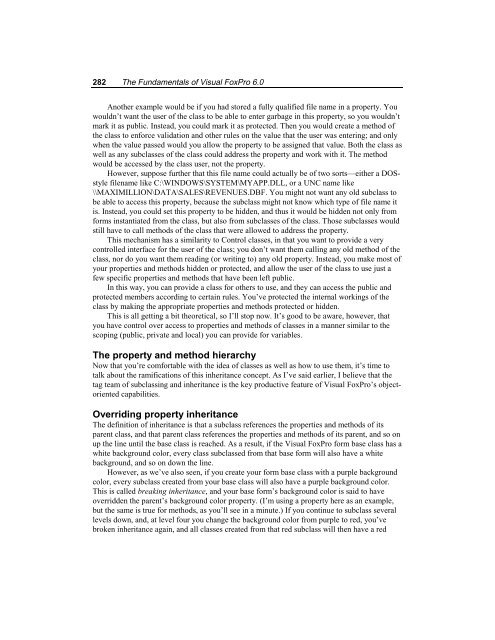Chapter 10 Using VFP's Object- Oriented Tools - dFPUG-Portal
Chapter 10 Using VFP's Object- Oriented Tools - dFPUG-Portal
Chapter 10 Using VFP's Object- Oriented Tools - dFPUG-Portal
Create successful ePaper yourself
Turn your PDF publications into a flip-book with our unique Google optimized e-Paper software.
282 The Fundamentals of Visual FoxPro 6.0<br />
Another example would be if you had stored a fully qualified file name in a property. You<br />
wouldn’t want the user of the class to be able to enter garbage in this property, so you wouldn’t<br />
mark it as public. Instead, you could mark it as protected. Then you would create a method of<br />
the class to enforce validation and other rules on the value that the user was entering; and only<br />
when the value passed would you allow the property to be assigned that value. Both the class as<br />
well as any subclasses of the class could address the property and work with it. The method<br />
would be accessed by the class user, not the property.<br />
However, suppose further that this file name could actually be of two sorts—either a DOSstyle<br />
filename like C:\WINDOWS\SYSTEM\MYAPP.DLL, or a UNC name like<br />
\\MAXIMILLION\DATA\SALES\REVENUES.DBF. You might not want any old subclass to<br />
be able to access this property, because the subclass might not know which type of file name it<br />
is. Instead, you could set this property to be hidden, and thus it would be hidden not only from<br />
forms instantiated from the class, but also from subclasses of the class. Those subclasses would<br />
still have to call methods of the class that were allowed to address the property.<br />
This mechanism has a similarity to Control classes, in that you want to provide a very<br />
controlled interface for the user of the class; you don’t want them calling any old method of the<br />
class, nor do you want them reading (or writing to) any old property. Instead, you make most of<br />
your properties and methods hidden or protected, and allow the user of the class to use just a<br />
few specific properties and methods that have been left public.<br />
In this way, you can provide a class for others to use, and they can access the public and<br />
protected members according to certain rules. You’ve protected the internal workings of the<br />
class by making the appropriate properties and methods protected or hidden.<br />
This is all getting a bit theoretical, so I’ll stop now. It’s good to be aware, however, that<br />
you have control over access to properties and methods of classes in a manner similar to the<br />
scoping (public, private and local) you can provide for variables.<br />
The property and method hierarchy<br />
Now that you’re comfortable with the idea of classes as well as how to use them, it’s time to<br />
talk about the ramifications of this inheritance concept. As I’ve said earlier, I believe that the<br />
tag team of subclassing and inheritance is the key productive feature of Visual FoxPro’s objectoriented<br />
capabilities.<br />
Overriding property inheritance<br />
The definition of inheritance is that a subclass references the properties and methods of its<br />
parent class, and that parent class references the properties and methods of its parent, and so on<br />
up the line until the base class is reached. As a result, if the Visual FoxPro form base class has a<br />
white background color, every class subclassed from that base form will also have a white<br />
background, and so on down the line.<br />
However, as we’ve also seen, if you create your form base class with a purple background<br />
color, every subclass created from your base class will also have a purple background color.<br />
This is called breaking inheritance, and your base form’s background color is said to have<br />
overridden the parent’s background color property. (I’m using a property here as an example,<br />
but the same is true for methods, as you’ll see in a minute.) If you continue to subclass several<br />
levels down, and, at level four you change the background color from purple to red, you’ve<br />
broken inheritance again, and all classes created from that red subclass will then have a red

















